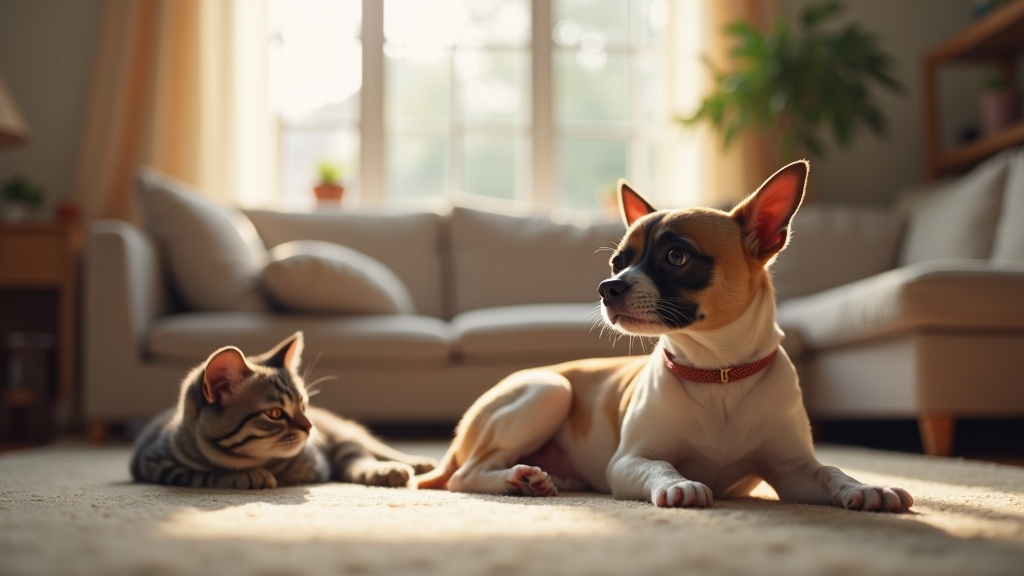Setting up a home security system is always a smart move, but when you have pets, it comes with some extra twists. Nobody wants to deal with daily false alarms or a stressed-out cat hiding every time the system chirps. Luckily, with the rise of AI-powered home security systems, it’s now easier than ever for pet owners to keep their homes safe while letting their furry friends roam comfortably. Here’s everything I’ve learned about getting the right setup when you share your space with pets.

Why AI Home Security Is Worth Checking Out for Pet Owners
AI home security isn’t just a passing trend, and it’s especially handy if you have pets at home. Traditional security systems easily trigger from a dog wandering through the living room or a cat leaping from the windowsill. AI-powered setups employ smart detection algorithms to tell the difference between a human and your Shih Tzu. That means fewer false alarms and a steadier daily routine for everyone.
According to a 2023 report from Security.org, more than half of pet owners said their biggest headache with security systems was unnecessary alerts caused by pets. AI-based features aim to fix that, learning the shape, size, and behavior patterns of household animals over time. So if you’ve skipped security setups because you thought your furry friend would just set it off, today’s technology finally has your back.
Getting Started: Setting Up AI Home Security with Pets in Mind
Every home is different, but pet owners should know a few musts before installing an AI-powered system. Most setups include a base station, motion sensors, contact sensors for doors and windows, a few cameras, and mobile app connectivity. Choosing hardware for pets doesn’t have to break the bank. Here’s what I’d pay extra attention to:
- Pet-Friendly Motion Sensors: Look for sensors that ignore movement below a certain weight—usually up to 80 pounds. The system uses AI to filter out what it believes are pets, so your dog’s wagging tail won’t trip the alarm every time she walks past.
- Smart Cameras: Top-rated indoor and outdoor cameras now use AI object detection that recognizes household pets and tags them differently from strangers or vehicles.
- Custom Rules and Zones: Most AI systems let you set “activity zones”: areas where movement is either ignored or monitored differently based on time of day. This is perfect if your cat loves sleeping in the sun room but you still want alerts at the front door.
- Integration with Mobile Apps: Controlling everything from your phone means you can snooze alerts or check in on live feeds while you’re out and about.
Quick Guide: Steps for a Smooth Security Setup When You Have Pets
Getting your home secure without causing chaos for your pets is very achievable. Here’s how:
- Choose Pet Immune Sensors: Make sure motion detectors are labeled as “pet immune” or have adjustable sensitivity settings.
- Select AI Cameras That Recognize Pets: Popular brands like Arlo, Wyze, and Nest offer AI-powered options that can tell a human from a four-legged friend, thanks to pattern recognition algorithms.
- Test Your System in Real Life: Walk around your house with your pets, watching for any alerts or problems. It can take some trial and error to get settings just right, so don’t rush the process.
- Spot Tune Notification Settings: Use your phone app to adjust notification types and frequency until you’re only getting the info you want. Every squirrel chase doesn’t need to trigger your phone.
- Set Up Schedules and Geofencing: Program the system to arm automatically when you leave and disarm when you return. This avoids unnecessary alarms during your usual comings and goings.
AI-powered home security systems give you loads of control. Spending time up front dialing in the details can save a lot of hassle later on.
Things Pet Owners Should Consider Before Buying an AI-Powered Security System
No security setup is entirely hands-off. Here’s what to keep in mind when shopping for hardware and mapping out your home setup:
- Sensor Placement: Place motion sensors at heights that skip most of your pet’s usual activities. For dogs, mounting four or five feet up from the ground usually works. For cats, avoid pointing sensors at shelves or window ledges you know they like to get to.
- Camera Angles: Angle AI cameras toward entrances, not at food bowls or litter boxes. This cuts down pet-related recordings. You can also mask off zones in most apps.
- Pet Size and Activity Level: The bigger and more active your pet, the more likely they’ll trigger sensors—at least in the beginning. Systems using machine learning tend to grow smarter over time as you review and label clips.
- Noise Levels: Some alarms emit high-pitched sounds that annoy sensitive pets. Test different chimes or notifications to see what your pets tolerate best.
- Backup Power: If you travel often or live where power is spotty, pick systems with battery backups. This way, your furry friends aren’t left vulnerable during an outage.
Can You Have an Alarm System with Pets?
Absolutely! With the right gear, living with pets and a home security system is easy. Modern systems—especially those powered by AI—are built to handle pets without constantly tripping false alerts. As long as your sensors are either labeled “pet immune” or adjustable for weight/height, you’re in good shape. Let the company know about your pets during setup, and walk someone through your pet’s favorite spots to minimize issues.
Does SimpliSafe Work with Pets?
SimpliSafe is among the most popular DIY home security systems, and it’s good for households with pets. Their motion sensors ignore animals up to 50 pounds. If you have a bigger dog—or a tiny, super energetic one—experiment with placement or reach out to support if you’re getting unwanted alerts. Many users mount the sensors higher on the wall to avoid picking up smaller pets. The SimpliSafe indoor camera uses basic motion detection, but with careful setup, including zones and lowered sensitivity, most pet-related problems can be minimized.
How Is Home Security Powered By AI?
AI in home security uses computer vision and machine learning to look at video and sensor data. When your camera senses movement, AI decides whether it’s your pet, a person, or something harmless, like a branch moving. These systems improve over time as you interact with the app, correcting mistakes if your dog gets flagged as an “unknown person.” In practice, you get smarter notifications and less phone noise. You’ll pay more attention to real alerts, without a swarm of pet messages getting in the way.
Do Home Security Cameras Pick Up Pets?
Home security cameras definitely pick up pets. The quality of the experience depends on your system. Traditional cameras couldn’t tell a Labrador from a burglar, but AI cameras use shape and movement to filter out most animals. You can also tag events in the app, marking your cat if she’s flagged as a visitor, so the AI improves. Systems like Ring, Arlo, or Google Nest have decent pet filtering now, though some manual fine-tuning may still be needed at first.
Advanced Tips for Pet Owners Using AI-Powered Security
Once you’ve got things running smoothly, here are some extra tricks for a safe and pet friendly home:
Take Advantage of Two-Way Talk Features: Many smart cameras feature two-way audio. Use it to check in on my pets (and say hi) when you’re out. You can also speak through the camera to warn off strangers or delivery folks.
Pair Security with Smart Home Devices: Link your system with smart lighting or thermostats. For example, hallway lights can turn on when your camera detects your dog moving at night. This helps cut down barking or accidents if pets get spooked in the dark or by strange noises.
Create “Pet Check-In” Routines: Systems from brands like Wyze and Arlo allow scheduled check-ins throughout the day. A quick live video peek can ease your mind if you have anxious pets or want peace of mind during a busy workday.
Go-To Equipment Picks for Homes with Pets
Using pet friendly AI-powered devices makes a world of difference. Here are some top picks:
- Arlo Pro and Arlo Essential Cameras: Their AI detection updates often and can learn your pet’s habits.
- Wyze Cam Pan v3: Budget friendly with tracking features that work for both animals and humans.
- SimpliSafe: Reliable and comes with solid pet immune sensor technology. Their support team knows the concerns of pet owners, which helps a lot.
- Google Nest Cam: Smart notifications and easy integration with other smart home gear is a big plus.
You can also link your system to home automation platforms like Amazon Alexa or Google Home for added convenience. Voice commands let you arm or disarm everything on the fly—even when your hands are full with leashes and treat bags.
Frequently Asked Questions
Here are some questions fellow pet parents often ask when considering AI security at home:
Can I use motion sensors with dogs and cats at home?
Answer: Yes, as long as you choose pet-immune models and experiment with where you install them. Check test clips before locking in their spots to avoid annoying alerts.
Will cameras record my pets all day?
Answer: Most new cameras will pick up pet movement, but with AI features and custom zone settings, you won’t be overloaded with alerts. Adjust the rules so you only get a heads up for genuine security events.
How do I avoid my pet getting spooked by security sounds?
Answer: Try different alarm tones or notifications and use light cues where possible. Start at a low volume to see how your pets react and gradually adjust if needed.
Final Thoughts
AI-powered home security systems provide true peace of mind for pet owners. With the right sensors, cameras, and a bit of setup effort, you can keep your home safe without stressing out your pets or yourself. Smart features make it possible to tune out what doesn’t matter, while keeping your furry best friends secure and comfortable at home.
